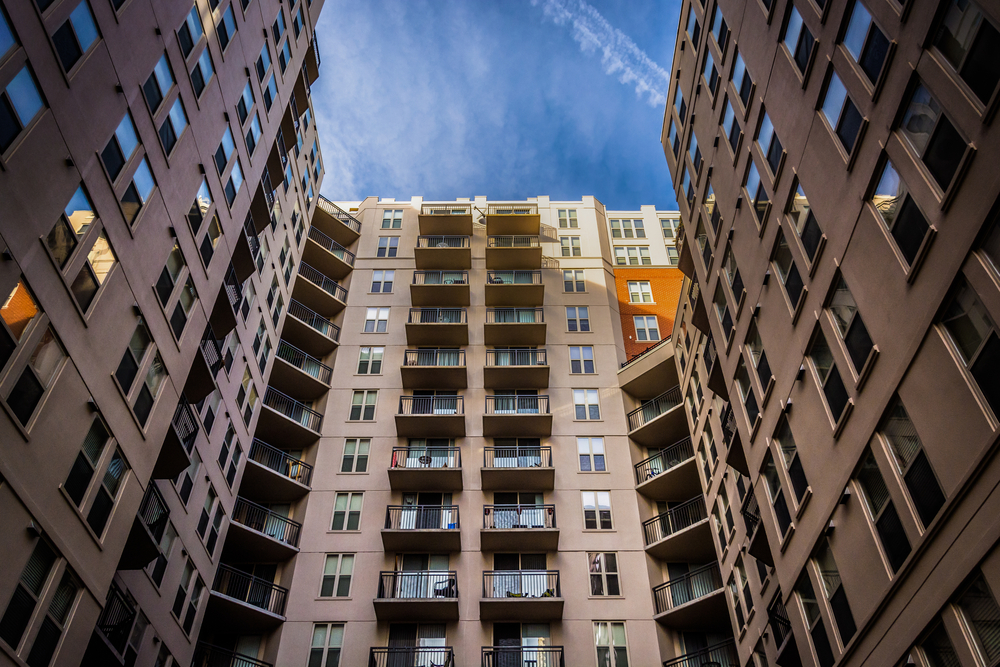In High-Rise Apartments, Exposure to Short-Term Rentals Weighs on Rent Collections

While apartment rent collections continue to far outpace expectations, one pesky weak spot persists: high-rise properties predominantly located in urban centers. That weakness ran counter to otherwise above-average collections in big cities generally and in Class A properties specifically.
What gives?
High-rise challenges trace primarily to high exposure to short-term rentals, or STRs. Apartment operators have reported that some STRs have been unable to pay rent on their master leases, and some have abandoned their units – and accompanying furniture – altogether.
The impact has been negligible for the apartment sector overall, simply because STRs comprise a very small share of the total pie. Experts estimate STRs lease about 10,000 apartment units among the more than 20 million rental apartments nationally. However, STRs comprise a more meaningful share in the downtown submarkets of many major cities. And they appear to particularly favor high-rise buildings.
Overall, apartment operators collected rent payments from 87.7% of occupied high-rise units through May 13. That’s the lowest among building types and nearly 2 percentage points below the average collection rate for Class A properties. (Most high-rises are classified as Class A.) April numbers showed similar trends.
For those unfamiliar, STRs marry the traditional corporate lease with an Airbnd-style flexible stay model. STRs rented out blocks of apartment units – and sometimes entire properties – on a master lease, then marketed those units for short-term stays. The model is intended to give apartment operators rent and occupancy without the marketing expense.
Prior to COVID-19, STRs were riding high as one of the up-and-coming prop techs in all of commercial real estate. Some raised hundreds of millions in funding on the idea that they would disrupt the urban hospitality market.
But it didn’t take long for COVID-19 to expose weakness in the STR business model. One of the largest, Stay Alfred, has closed for good after suspending operations in April. Another, Sonder – which appeared on Forbes’ list of “The Next Billion Dollar Startups” in 2018 – laid off or furloughed 400 people and has been trying to negotiate concessions. Other firms, like Airbnb-backed Lyric, also reported layoffs.
In the second half of March, travel had basically shut down – severely impacting all hospitality players, STRs included. We heard from apartment executives who were shocked to find some STRs had very little in cash reserves available even to pay rent for April. Some STRs asked for rent abatements. Others gave back units – furniture included – and walked away.
Leftover furniture created a unique problem. Apartment operators don’t own the furniture, leaving them limited options – such as holding furniture as collateral. But used furniture has relatively little value – worth “nickels on the dollar” as one executive put it.
The shutdown has led to much pontificating about the future of the multifamily STR business model. One increasingly popular view is that apartment operators will move to assert more control. Even prior to COVID-19, some had expressed angst over the relationship. Prospective renters looking for a traditional apartment were sometimes confused by Google results showing the same property available for short-term lease from a different website. And short-term guests with a bad experience often blamed the apartment manager instead of the STR, dinging the property’s reputation score that operators work hard to protect.
Will larger apartment operators try to run their own STR businesses? It’s possible. Some already run their own corporate housing businesses, while others outsource to third-party players. That means they already have furniture, cleaning crews, manpower and technology to. (As a refresher: Traditional corporate housing sets aside furnished units for businesses to provide housing to employees who are either relocating or visiting on extended stays, but these units are not marketed to individual consumers. That business has been more stable, by all accounts, as corporate clients are generally paying the bills even if they’re not using the units.)
Marketing has been one big roadblock in the past. STRs bring people. But as one apartment executive told me recently, the demand channels are much better today than they were a few years ago, with sites like Airbnd, HomeAway and Expedia.
Technology was another big hole. But now technology from companies like RealPage’s Kigo division makes it much easier for apartment operators to set aside apartment units for short-term stays. Smart locks and mobile apps remove the need for any direct human interaction when a guest arrives. Other operational tools – such as resident screening and call centers – could be adapted for short-term stays.
One big advantage of taking the STR model in house is that it allows apartment operators to flex up or down how many units to set aside for short-term stays based on demand. It also allows operators to enjoy more of the revenue upside, and hedges them against a downside of unpaid rent when demand fizzles.
Even if they continue to rely on third-party STRs, we could see more apartment operators pushing to replace the traditional master lease with a revenue-sharing model that gives them more upside and more flexibility.






